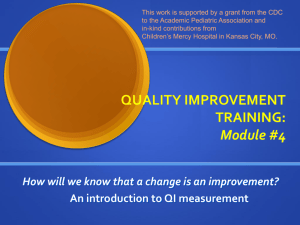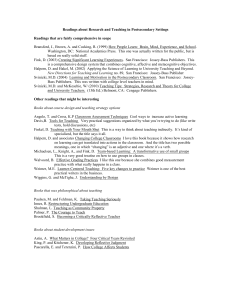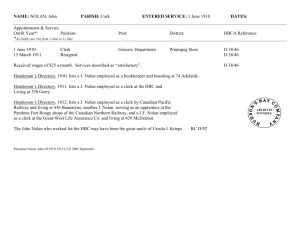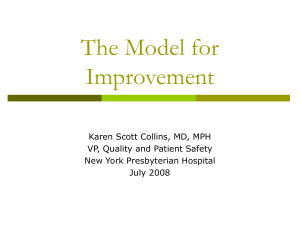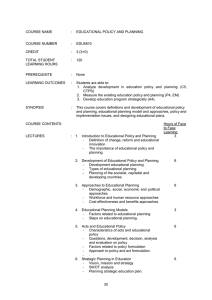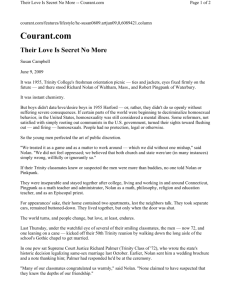quality of health care
advertisement
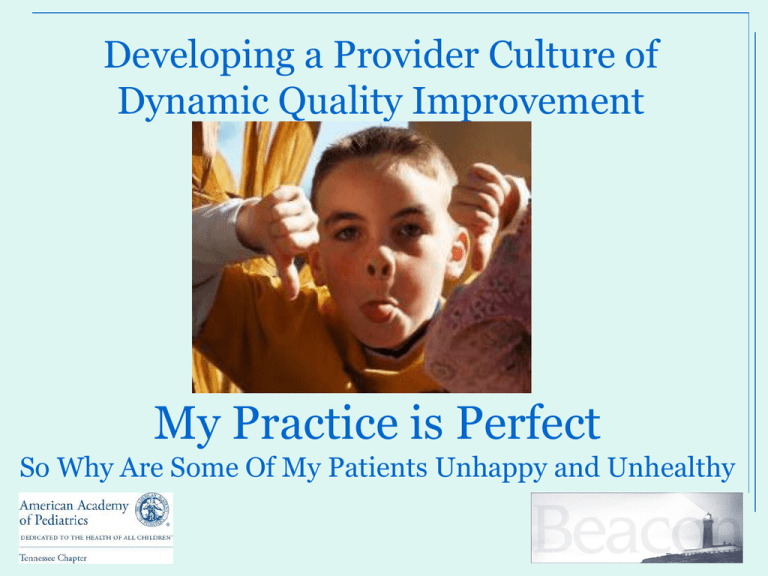
Developing a Provider Culture of Dynamic Quality Improvement My Practice is Perfect So Why Are Some Of My Patients Unhappy and Unhealthy Quality Health Care “Problems in health care quality are serious and extensive; they occur in all delivery systems and financing mechanisms. Americans bear a great burden of harm because of these problems, a burden that is measured in lost lives, reduced functioning, and wasted resources. Collectively, these problems call for urgent action.” Institute of Medicine, Committee on Quality of Health Care in America. Crossing the Quality Chasm. A New Health System for the 21st Century. Washington, DC: National Academy Press; 2001 Quality Health Care “The Institute of Medicine outlines 6 aims for improving our nation’s health care system by stating that all health care should be safe, effective, patient-centered, efficient, equitable, and timely. “ Institute of Medicine, Committee on Quality of Health Care in America. Crossing the Quality Chasm. A New Health System for the 21st Century. Washington, DC: National Academy Press; 2001 Quality Health Care The quality of health care is defined as the degree to which health services for individuals and populations increase the likelihood of desired health outcomes and are consistent with current professional knowledge. Donald Berwick How Do We Define Health Care Three Domains of Health Care 1. Structural 2. Processes 3. Outcomes How Do We Define Health Care Three Domains of Health Care 1. Structural – tools available for care 2. Processes – activities we do 3. Outcomes - results How Do We Define Health Care Indicators Indicators are the metrics we use to measure the element of the three domains. As medical professionals, we are used to working with these. Vital signs are a outcome metric we use all the time. Types of Quality Problems 1. Overuse – risk of potential harm exceeds the possible benefit 2. Underuse – opportunity for likely favorable outcome missed 3. Misuse - appropriate service causes a preventable complication and full potential benefit not acheived Six Health Care Improvement Dimensions 1. Safe - Avoiding injuries to patients from the care 2. Effective - Providing services based on scientific knowledge 3. Patient-centered - respectful of and responsive to individual 4. Timely - reducing delays 5. Efficient - avoiding waste 6. Equitable – patient doesn’t impact the quality of service offered Institute of Medicine, Committee on Quality Health Care in America. Crossing the Quality Chasm. A New Health System for the 21st Century. Washington, DC: National Academy Press; 2001. I Wish My Practice Was This Simple A Better Model of My Practice Health Status Gender Direct Effects of Practice Variables on Patient Outcome Care Coordination Family Age Communication A Better Model of My Practice Health Status RHS Numerous Direct and Indirect Effects of Practice Variables on Patient Outcome RCC Care Coordination RF Family RP Age RA Communication R=Residual Error RC Blalock HM, Causal Models in the Social Sciences, Aldine Publishing Co., 1999. Building Blocks of Quality Improvement Focus on PROCESS Both internal and external CUSTOMER driven Use objective DATA to make decisions Building a Team for Quality Improvement • Multidisciplinary Team MD Nursing Lab IT Billing • • • Office Staff Medical Records Management Clear involvement of leadership Variable sponsorship Efficient communication Meet regularly Foster “No Bad Suggestion” culture Quality Improvement Model The Model for Improvement, as seen on the Institute for Healthcare Improvement’s website (IHI.org), was developed by Associates in Process Improvement [Langley, Nolan, Nolan, Norman, Provost. The Improvement Guide. San Francisco: Jossey-Bass Publishers; 1996]. Quality Improvement Model The Model for Improvement, as seen on the Institute for Healthcare Improvement’s website (IHI.org), was developed by Associates in Process Improvement [Langley, Nolan, Nolan, Norman, Provost. The Improvement Guide. San Francisco: Jossey-Bass Publishers; 1996]. What Are We Trying To Accomplish? AIM Use quality indicators to make a list of problems faced by your practice or opportunities for change. Prioritize the problems or opportunities for change Make goal improvement unambiguous and achievable Be clear on boundaries What Change Can We Make That Will Result in Improvement? Change Concepts Eliminate waste Improve work flow Optimize inventory – Vaccines Change the work environment Improve provider/customer experience Improve time efficiencies Decrease variation in the process Mistake proofing Improve product or service Langley G et al. The Improvement Guide. Josey-Bass Publishers, San Francisco, 1996; xxi, p295. What Are We Trying To Accomplish? AIM Use quality indicators to make a list of problems faced by your practice or opportunities for change. Prioritize the problems or opportunities for change Make goal improvement unambiguous and achievable Be clear on boundaries What Are We Trying To Accomplish? AIM FOCUS on what is important to your organization not what is sexy STEAL shamelessly What Are We Trying To Accomplish? AIM Avoid AIM drift Be ready to refocus – always learn from current data set Pilot, try a panel of strategy and spread What Are We Trying To Accomplish? AIM HOW GOOD? BY WHEN? What Are We Trying To Accomplish? AIM HOW GOOD? BY WHEN? Highland Pediatrics will decrease mean registration to physician time by 20% in 18 months. What Are We Trying To Accomplish? AIM HOW GOOD? BY WHEN? Highland Pediatrics will offer 3 possible well care visits times within 48 hours of parental request within the next 6 months. What Are We Trying To Accomplish? AIM HOW GOOD? BY WHEN? Highland Patients will decrease ER or hospital admissions in known Asthma patients by 15% in 12 months. What Are We Trying To Accomplish? AIM HOW GOOD? BY WHEN? Highland Pediatrics babies will have completed maternal Edinburgh screens on the chart for the one and four months visits for 90% of patients in 12 months. Quality Improvement Model The Model for Improvement, as seen on the Institute for Healthcare Improvement’s website (IHI.org), was developed by Associates in Process Improvement [Langley, Nolan, Nolan, Norman, Provost. The Improvement Guide. San Francisco: Jossey-Bass Publishers; 1996]. How will we know a change is an improvement? Know that progression is vital BUT can be painful How will we know a change is an improvement? Challenges Adds work Threatening – I plead the 5th Difficultly with accuracy and consistency Using the data to take action Manual vs Automated Management’s reality conflicts with data Measured elements chosen inappropriately Lack of training in data collection and analysis How will we know a change is an improvement? Opportunity Healthier and more effective decision making process Progress (or lack of) can be followed Build a defined platform for improvement and areas of opportunity Build confidence in understanding of operations Everyone is talking a similar language Easier to see trends – move to proactive instead of reactive Focus on important items Data sells ideas and limits the power of dramatic anecdote How will we know a change is an improvement? Rules QI is for learning how well what you do correlates with what you want to do QI is not to build a case to punish someone “All measures have limits, but limitations do not negate value.” Use a “balanced set of measures” Focus on a VITAL FEW forget the common many Data plotted over time How will we know a change is an improvement? Steps AIM Statement Concept Measures Operational Definition Data Collection Analysis Test Change How will we know a change is an improvement? Operational Definition Clear and not ambiguous Measurement methods Measurement equipment Identifies criteria Specific measures Ends with numerator/ denominator How will we know a change is an improvement? Run Chart Measure over time Common and Special Causes Dr Coffman - Edinburgh Screening 1.20 1.00 0.80 one month four month 0.60 Balance 0.40 0.20 0.00 Q2/11 Q3/11 Q4/11 Q1/12 Q2/12 Q3/12 Q4/12 Q1/13 Quality Improvement Model The Model for Improvement, as seen on the Institute for Healthcare Improvement’s website (IHI.org), was developed by Associates in Process Improvement [Langley, Nolan, Nolan, Norman, Provost. The Improvement Guide. San Francisco: Jossey-Bass Publishers; 1996]. What Change Can We Make That Will Result in Improvement? “All improvement will result in change. All change will not result in improvement” “Every system is perfectly designed to get the precise results that it gets” What Change Can We Make That Will Result in Improvement? Do a detailed analysis of your area of concern Review the current Evidence-Based Medicine Review Benchmarks (ie, learning from superior performers in the area chosen for improvement) Advice from experts or others who have attempted improvement in similar topics Brainstorming, critical thinking, and hunches about the current system of care Don’t reinvent the wheel What Change Can We Make That Will Result in Improvement? Change Concepts Eliminate waste Improve work flow Optimize inventory – Vaccines Change the work environment Improve provider/customer experience Improve time efficiencies Decrease variation in the process Mistake proofing Improve product or service Langley G et al. The Improvement Guide. Josey-Bass Publishers, San Francisco, 1996; xxi, p295. Quality Improvement Model The Model for Improvement, as seen on the Institute for Healthcare Improvement’s website (IHI.org), was developed by Associates in Process Improvement [Langley, Nolan, Nolan, Norman, Provost. The Improvement Guide. San Francisco: Jossey-Bass Publishers; 1996]. How To Use a PDSA Cycle Plan Describe the change to be tested. What do you predict will happen? When will you conduct the test? Who will be involved? Who needs to know about the test? How will you conduct the test? Do Conduct the test. Document what happened. Study Discuss the results of the test. How do your results compare with your predictions? What did you learn? Act Based on the results of the test adopt, adapt, or abort the change. Overview on Testing Change Must have a THEORY and a PREDICTION Test on small scale and collect data over time Build on your understanding with multiple PDSA cycles for each change idea Look at change over a wide range on circumstances as you sequence through your PDSA cycles How will we know a change is an improvement? Change Concept Theory and Prediction Testing Change Concept Test over a spectrum of conditions Applying Change Concept Become routine operation Universalization How will we know a change is an improvement? AIM: Improve infant care of depressed mothers by better screening mothers at one and four month visits Having moms fill out Edinburgh Screening Tool will help identify mothers at risk for severe post partum depression Data Cycle 1: MD gives mom Edinburgh Screening Tool to complete during exam to 3 moms 15% have EST Cycle 2: MD gives screen to all moms for a month Cycle 3: RN introduces screen during rooming, MD grades Cycle 4: All staff oriented to use of Edinburgh Screen Tool 90% have EST How will we know a change is an improvement? Change Concept Theory and Prediction Testing Change Concept Test over a spectrum of conditions Applying Change Concept Become routine operation Universalization PDSA Cycle Why did you succeed? Why did you fail? What further changes do you now need to make in order to succeed? Were there unintended consequences or harm created by your change attempts? Concept Triangle Change ConceptI want to minimize my vaccine inventory Concept Triangle IdeaOnly order to replace what we have used that month Change ConceptI want to minimize my vaccine inventory Concept Triangle Idea ConceptNot overstock by over ordering IdeaOnly order to replace what we have used that month Change ConceptI want to minimize my vaccine inventory Concept Triangle Another way to do that idea conceptIdea ConceptNot overstock by over ordering IdeaOnly order to replace what we have used that month Track our use from last year and purchase potential deficient compared to current stock Change ConceptI want to minimize my vaccine inventory Concept Triangle Another way to do that idea conceptIdea ConceptNot overstock by over ordering IdeaOnly order to replace what we have used that month Track our use from last year and purchase potential deficient compared to current stock Change ConceptI want to minimize my vaccine inventory Summary My Mind Set Think like your customer for the problem at hand Focus on processes – How you do what you do Use DATA My Map and Compass My AIM – What am I trying to accomplish How do I know a change is an improvement? What change can I make that will result in improvement? My Transportation Start SMALL and end with ALL Build your understanding of your processes through sequential testing Test, Implement, Spread References Berwick DM. Developing and testing changes in delivery of care. Ann Intern Med1998;128(8):651-656. Chassin MR, Galvin RW. The urgent need to improve health care quality. Institute of Medicine National Roundtable on Health Care Quality. JAMA. 1998;280(11): 1000-1005. Clemmer TP, Spuhler VJ, Berwick DM, Nolan TW. Cooperation: the foundation of improvement.Ann Intern Med. 1998;128(12):1004-1009. Council on Medical Service. Quality of care. JAMA.1986;256(8):1032-1034. Donabedian A. The Definition of Quality and Approaches to its Assessment. Ann Arbor, MI: Health Administration Press, 1980. Explorations in Quality Assessment and Monitoring; vol 1. Horbar JD. The Vermont Oxford Network: evidence-based quality improvement for neonatology.Pediatrics. 1999;103(1)(suppl E):350-359. Institute of Medicine, Committee on Quality of Health Care in America. Crossing the Quality Chasm. A New Health System for the 21st Century. Washington, DC: National Academy Press; 2001. Langley GJ, Nolan KM, Nolan TW, Normal CL, Provost LP. The Improvement Guide. A Practical Approach to Enhancing Organizational Performance. San Francisco, CA: Jossey-Bass Publishers; 1996. E):203-214. Lloyd R. An Introduction to the Model for Improvement. The Institute for Healthcare Improvement . 2007-06-29 Mangione-Smith R, DeCristofaro AH, Setodji CM, et al. The quality of ambulatory care delivered to children in the United States. N Engl J Med. 2007;357(15):1515-1523. Perla RJ, Provost LP, Murray SK. Sampling considerations in health care improvement. Quality Management in Health Care. 2013 Jan/Mar;22(1):36-47. Plsek PE. Quality improvement methods in clinical medicine. Pediatrics. 1999;103(1)(suppl
